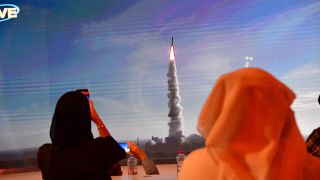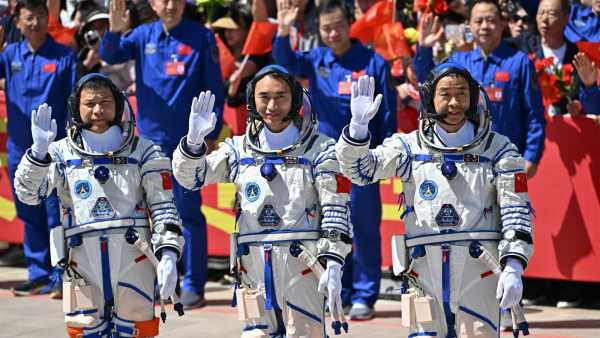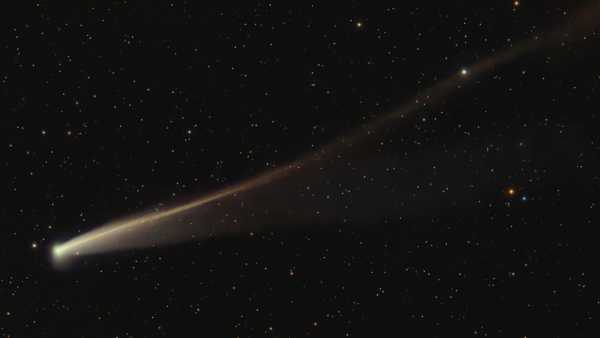
A picture taken on July 19, 2020, shows a screen broadcasting the launch of the “Hope” Mars probe at the Mohammed Bin Rashid Space Center in Dubai.
The United Arab Emirates’ probe Hope is on its way to Mars, marking the first planetary science mission led by an Arab country.
A July 19 launch from Japan marked the start of Hope satellite’s journey to Mars. But the project (named Al-Amal in Arabic, which translates to Hope in English) has been underway for six years, since UAE president Sheikh Khalifa bin Zayed Al Nahyan announced the project in July 2014. Hope will orbit the Red Planet, collecting data on its atmosphere in order to offer scientists better information about Mars’s possible life-giving past and more barren present.
“We chose the epic challenge of reaching Mars because epic challenges inspire and motivate us,” Mohammed bin Rashid, vice president and prime minister of the country, said in a 2014 statement, as Live Science sister site Space.com reported. “The moment we stop taking on such challenges is the moment we stop moving forward.”
For the UAE, the Hope project offers an opportunity to build a more robust scientific community, to build national prestige, and to contribute directly to the global effort to uncover historical life on Mars, according to the Emirati space agency.
What is the United Arab Emirates?
The UAE is a young nation with a population of less than 10 million (according to Global Media Insight) on the southeastern part of the Arabian peninsula, bordering Saudi Arabia and Oman, and across the Persian Gulf from Iran. It formed in 1971 out of seven smaller nations, or emirates, that had until then been under British colonial rule. (Hope’s 2021 arrival at Mars is scheduled coincide with the UAE’s 50th anniversary.)
Abu Dhabi and Dubai, the largest emirates, account for most of the Emirati population, but about a third of all people in the UAE live in the other five emirates: Sharjah, Ajman, Ras al-Khaimah, Fujairah and Umm al-Quwain.
The UAE is a wealthy oil producer and, like neighboring Saudi Arabia, has long been an ally and trading partner of the United States. The country has cash to spare on major national projects like the world’s tallest building in Dubai, artificial Islands and an indoor ski resort in the middle of the desert.
Hope has been part of a loftier national project that has also seen the construction of the Mohammed bin Rashid Space Center — which runs the Hope mission — the establishment of an astronaut program and Emirati citizen Hazzaa Ali Almansoori’s eight-day stint as an astronaut aboard the International Space Station in 2019.
What will the Hope probe do?
Hope, a joint project between UAE and the University of Colorado Boulder, University of California, Berkeley, and Arizona State University, is in essence a very advanced weather satellite, according to Space.com.
It’s designed to create a long-term, planet-wide picture of the Martian climate, showing how the planet’s weather patterns shift over days and years. Scientists hope to use its data to work out the mechanisms that leached oxygen and hydrogen out of the Martian atmosphere over eons.
Those processes left the planet dry, frigid and barren. But the hunt for life on Mars relies on the assumption — backed up by evidence from the planet’s surface — that billions of years ago it was warmer and wetter with plenty of oxygen to go around. Understanding how the atmosphere is changing today could, researchers hope, help flesh out the picture of a more ancient Mars where life may have developed.
A scientific boost for the gulf nation
More immediately, the goal of the space program is to build up the UAE’s standing in the global scientific community and establish serious research institutions in the country, the UAE said.
The Mohammed bin Rashid Space Center lists Hope mission goals on its website, including to “encourage and inspire young generations to be successful in STEM projects” and “promote a culture of research and passion for exploration and innovation.”
So far, the UAE’s efforts seem to be paying off.
“With no previous domestic space exploration experience, planetary science capacity or suitable infrastructure, the nation managed to put together a delivery team of 100% local, Emirati staff with an average age of under 35,” University College London researchers Ine Steenmans and Neil Morisetti wrote for The Conversation. “And setting a deadline of six years rather than ten, as most comparable missions do, it pulled the launch off on time and within budget.”
Steenmans, Morisetti and their colleagues published a glowing review of the mission, saying that the Hope effort had driven a small scientific explosion for the UAE, with over 50 peer-reviewed space science papers coming out of the country in the last six years.
RELATED
—Voyager to Mars Rover: NASA’s 10 greatest innovations
—See spectacular lunar mission images in 3D (Photos)
—Photos: A look at China’s space station that’s crashing to Earth
In the process, the UAE also developed the know-how and manufacturing infrastructure for other, similar projects in the future, the researchers wrote in their reveiw. More students in the UAE have enrolled in graduate science degree programs; more funding is available to scientists in the country; and research looks like a more attractive career than it did before this mission took off, they said.
“One of the lessons is therefore that when embedded within a long-term, national strategic vision, space exploration can in the short-term generate major benefits close to home,” they wrote. “While space may appear to primarily be about missions for science, when designed in this way, they can be missions for national development.”
The UAE isn’t alone among post-Cold War powers using space exploration to mark their status and power, and elevate national ambitions. China, despite being locked out of collaboration with NASA, has built its own space stations and landed rovers on the moon. Israel’s Beresheet lander failed spectacularly when it crashed into the moon in 2019 (though the crash did send thousands of dried-up tardigrades onto the lunar surface). And India has launched several satellite probes, including the Mars Orbiter Mission that has been circling the Red Planet since 2014.
As Forbes reported in 2018, only about 40% of all Mars missions in history have been successful. So it remains to be seen whether Hope, due to arrive in February 2021, will be seen as a total success for the UAE’s scientific ambitions.
Originally published on Live Science.
Sourse: www.livescience.com





